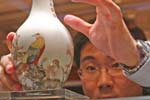Money
Currencies continue run of increases
Updated: 2011-04-11 14:41
By Yumi Teso (China Daily)
BANGKOK - Asian currencies strengthened for a third week, the longest run of gains since October, as overseas investors added to holdings of regional assets to benefit from the world's fastest economic growth.
The Bloomberg-JPMorgan Asia Dollar Index, which tracks the region's 10 most-traded currencies, rose to a 13-year high as funds based abroad bought about $3 billion more South Korean, Chinese and Thai equities than they sold last week. China, India, Indonesia, South Korea, the Philippines and Thailand have all raised interest rates this year to tame inflation, boosting the yield advantage over developed nations.
The Taiwan dollar appreciated 1.1 percent to NT$28.991 against the greenback last week, according to Taipei Forex Inc. India's rupee gained 1.2 percent to 44.0790, the Philippine peso advanced 0.9 percent to 43 and the Thai baht climbed 0.8 percent to 30.04.
Emerging-market economies in Asia will expand 8.4 percent this year, compared with 2.5 percent growth in advanced countries, according to estimates released by the International Monetary Fund in January. Benchmark interest rates in Indonesia and India are 6.75 percent and the Chinese mainland's one-year lending rate is 6.31 percent, compared with a maximum of 0.25 percent in the US and Japan.
Yuan appreciation
China's yuan strengthened for a fourth week, the longest run of gains this year. The People's Bank of China (PBOC) should consider letting the currency appreciate to help temper prices and improve the balance of international payments, Zhu Baoliang, chief economist at the State Information Center, wrote in a commentary published on April 7 in the Shanghai Securities News.
"There are a lot of policy makers urging PBOC to use renminbi strength to help curb imported inflation," said Ho Woei-Chen, an economist at United Overseas Bank Ltd in Singapore.
The yuan rose 0.19 percent from a week ago to 6.5354 a dollar, according to the China Foreign Exchange Trade System. It touched 6.5350 on Friday, the strongest level since the country unified official and market exchange rates at the end of 1993.
Asia's lowest inflation
Taiwan's dollar had its biggest weekly advance in three months. The consumer price index climbed 1.41 percent in March from a year earlier, less than the 1.70 percent median estimate of economists surveyed by Bloomberg, official records showed on April 6. That's the lowest among Asia's 10 biggest emerging economies, according to data compiled by Bloomberg.
"Foreign inflows supported the Taiwan dollar last week," said Wee-Khoon Chong, a fixed-income strategist at Societe Generale SA in Hong Kong. "The lower-than-expected inflation number also helped the rally."
South Korea's won rose for a third week, climbing 0.8 percent to 1,083.03 a dollar. Policy makers will let the currency gain to curb inflation, Barclays Capital said ahead of an interest-rate review on April 12.
Elsewhere, Indonesia's rupiah added 0.6 percent last week to 8,648 a dollar, according to data compiled by Bloomberg. The Singapore dollar rose 0.4 percent to S$1.2570 and Malaysia's ringgit gained 0.3 percent to 3.0165.
Bloomberg News
Specials

Share your China stories!
Foreign readers are invited to share your China stories.

Art auctions
China accounted for 33% of global fine art sales.

Waiting for drivers' seat
Lack of sponsorship appears to be why Chinese drivers have yet to race in a Formula 1 event



